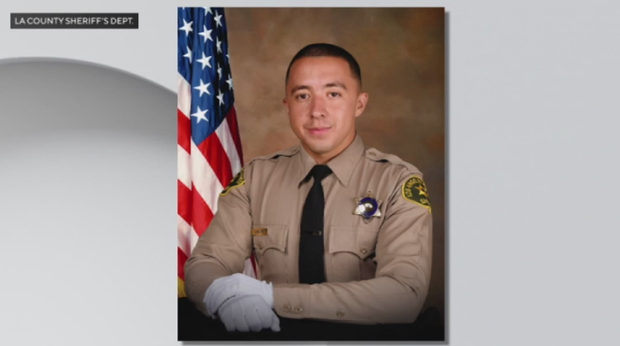In a tragic and harrowing development that has sent ripples of grief throughout Los Angeles County and beyond, Deputy Daniel V. Chavira—just 21 years old and in the earliest stages of a promising career in law enforcement—lost his life following a multi-vehicle collision in the Santa Clarita region. Deputy Chavira, who was off duty at the time of the incident, died from injuries sustained in a violent crash that took place along San Francisquito Canyon Road, south of Dry Gulch in the Saugus area. The accident, which involved three vehicles, has left an indelible scar on the hearts of his colleagues, his community, and most intimately, his deeply rooted law enforcement family, which includes his wife, siblings, and in-laws—all active members of the Los Angeles County Sheriff’s Department.
The California Highway Patrol (CHP), the primary agency investigating the fatal crash, reported that Chavira was critically injured and required urgent medical evacuation by air from the crash site. Despite the immediate efforts of first responders and the urgent medical attention he received, he was later pronounced dead. The scene was one of urgency and chaos—a testament to the suddenness with which life can pivot from promise to heartbreak. Four other individuals involved in the crash were transported by ambulance to nearby hospitals, but their identities and conditions remain undisclosed as of this writing, a fact that underscores the continuing complexity of the incident and the incomplete picture authorities are still trying to assemble.
As investigators work meticulously to determine the factors that contributed to the collision, the cause remains officially undetermined. Whether the crash was precipitated by excessive speed, mechanical malfunction, driver error, or another external factor is not yet known. The California Highway Patrol has indicated that the investigation remains active and ongoing, with efforts focused on reconstructing the sequence of events and interviewing any witnesses who may have observed what occurred in the moments before the vehicles collided.
Deputy Daniel V. Chavira’s life and death are significant not only because of his position within the Los Angeles County Sheriff’s Department, but also because of the broader narrative of service and dedication into which he was woven. Chavira had only recently joined the department, having entered the force in May 2024 as part of Academy Class 476. His assignment to the North County Correctional Facility placed him in a role of immense responsibility despite his relatively new status. It was a role he embraced with the sense of duty and honor that are foundational to the ethos of law enforcement, and it was quickly evident to those around him that his commitment was not perfunctory or superficial. In him, colleagues recognized not only a professional striving to uphold justice, but a young man deeply committed to the welfare and protection of his community.
The department’s leadership, grappling with the depth of this loss, issued heartfelt statements that encapsulated both the pain of Chavira’s sudden death and the pride in his service. Los Angeles County Sheriff Robert Luna spoke poignantly of the young deputy’s character, emphasizing how Chavira’s dedication to public safety transcended mere obligation. “We are heartbroken by the tragic loss of one of our own, who was taken from us far too soon,” Luna stated. “Our Deputy dedicated his life to the service and safety of others, both in and out of uniform. His commitment to public safety was not just a job—it was who he was.” These words reflect the layered sense of mourning felt not only by the department’s leadership, but by the broader community of law enforcement and civic stakeholders who understand how much promise was extinguished with Chavira’s passing.
To understand the magnitude of this loss, it is essential to recognize the deep familial roots that connected Daniel V. Chavira to the world of law enforcement. His father, Rodrigo Valencia, survives him, as do two brothers: Rodrigo Valencia and Deputy Rene Valencia-Chavira, who is currently stationed at the Lancaster Station. His wife, Deputy Crystal Valencia, is assigned to the San Fernando Court, while his sister, Detective Nancy Alcaraz, and her husband, Deputy Martin Alcaraz, both serve at the Palmdale Station. This profound interconnection within the law enforcement community makes Chavira’s death not only a personal loss for his immediate family, but a seismic event for an extended family bonded through the daily trials and responsibilities of public safety service.
The unique pain that such a family must endure is difficult to encapsulate. When an officer falls, it is always tragic. But when the loss is felt within a family of officers, it echoes with unbearable familiarity and a chilling reminder of the risks faced every day. The grief of a family accustomed to wearing the badge is not dulled by familiarity—it is deepened by it. Each uniformed family member likely carries within them a complex matrix of sorrow, guilt, honor, and memory, each emotion rooted in both love and shared professional identity.
This tragedy also serves as a stark reminder of how the dangers faced by law enforcement personnel extend beyond the job itself. Chavira was not on duty at the time of his death. He was not in pursuit of a suspect or responding to a call. He was, in that moment, a private citizen navigating the same roads as the rest of us—yet fate did not distinguish between uniform and plain clothes, between professional hazard and personal journey. It is this collision of public service and private vulnerability that makes his death particularly poignant, revealing how even off-duty moments are not immune from the tragedies that haunt human life.
In the days following the crash, a solemn procession was organized in Santa Clarita, an outpouring of collective grief and respect that served as a public acknowledgment of Chavira’s sacrifice and the community’s solidarity. Law enforcement personnel from across jurisdictions lined the streets, standing in silent tribute as the procession passed. The sight of uniforms from multiple agencies—shoulders squared, heads bowed—evoked the gravity of the moment with a quiet eloquence that words could not match. Residents of Santa Clarita also stood in solidarity, many pausing in their daily routines to offer gestures of mourning and respect. In that moment, the line between law enforcement and civilian life blurred, replaced by a shared human response to loss and tragedy.
The location of the crash—San Francisquito Canyon Road—adds another dimension to this story. Known for its winding curves and scenic stretches, the road has long been a thoroughfare that combines beauty with latent danger. While the article does not specify whether this roadway has a history of accidents, the nature of the crash suggests that this may be an area warranting closer scrutiny for safety enhancements, signage, or speed regulation. Whether or not the accident prompts renewed efforts by city or county officials to assess and possibly upgrade safety measures along the road remains to be seen, but the visibility of this incident will undoubtedly elevate public awareness about the conditions under which the crash occurred.
The fact that four other individuals were injured and taken to hospital introduces additional human dimensions to this tragedy. Although their names and current conditions have not yet been disclosed, their presence underscores that the ripples of this crash extend far beyond the Chavira family. Their families, too, are waiting—perhaps beside hospital beds, or at home with phones in hand—for updates that may forever alter their lives. These victims remain anonymized in the public record for now, but they are an integral part of the larger narrative, and their fates may further shape the legacy of this incident as more facts become known.
The ongoing investigation by the California Highway Patrol is expected to play a critical role in both clarifying the facts and shaping the future. Should the investigation reveal systemic issues—whether they be road safety deficits, traffic control shortcomings, or a broader pattern of collisions in the area—it could serve as a catalyst for policy discussions and preventive interventions. In the realm of public service, particularly where tragic loss is involved, data becomes a moral imperative: to learn, to reform, and to prevent recurrence. Until more details emerge, the story remains in a liminal space—part tribute, part inquiry, wholly heartbreaking.
At the core of this tragedy, however, remains the individual: Deputy Daniel V. Chavira. His death is not merely a line in a report or a name on a roster. It is a life—full of intention, trajectory, and meaning—cut brutally short. The fact that he had joined the department less than a year before his passing only deepens the sorrow. At 21 years old, his decision to pursue a career in law enforcement speaks volumes about his character. In an era when public service—particularly in policing—is fraught with challenge and scrutiny, his willingness to stand for justice and accountability is a testament to personal courage and moral conviction. He did not simply follow a family tradition; he contributed to it, with his own perspective, his own ideals, and his own ambitions.
The community’s mourning has only just begun. While funeral arrangements had not yet been formally announced at the time of reporting, the expectation is that the ceremony will draw a significant outpouring from within the law enforcement community and the general public alike. These gatherings serve not only to honor the fallen, but to affirm the social contract between those who serve and the communities they protect. They are occasions of mourning, certainly, but also of affirmation—of ideals, of courage, and of shared humanity.
In the days and weeks ahead, tributes will continue to flow. Some will come in the form of formal commendations or public ceremonies; others may be quieter—moments of reflection among colleagues, silent prayers from family members, or simple gestures of remembrance in the stations where Chavira once trained. These tributes, however they manifest, will collectively build the memory of a man whose time was short but whose impact was enduring.
Daniel V. Chavira’s story, though marked by tragedy, is also marked by meaning. His legacy is etched not only in his badge number or his academy class, but in the lives he touched, the family he loved, and the mission he served. In honoring him, we are called to reflect not only on the fragility of life, but on the profound strength that comes from living it with purpose.
As the final investigations unfold and more is understood about the circumstances of his death, what remains certain is that Deputy Daniel V. Chavira lived—and died—as a servant of the public good. He was a son, a husband, a brother, a friend, a protector. And while the loss is immeasurable, the memory is indelible. In him, the values of courage, duty, and service find a lasting symbol. His story is now part of the collective conscience of Los Angeles County, and his name will echo in the roll calls and the hearts of those who carry forward the badge he so proudly wore.




